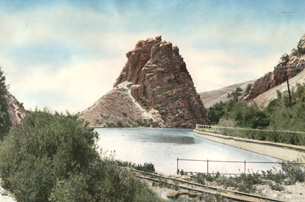Suicide Rock and the Parley’s Canyon Reservoir
LeRoy W. Hooton, Jr.
|
Although Suicide Rock was prominently visible from the highway, a significant piece of our water history was tucked out of sight below the line-of-sight of the highway. For over 60 years, the Parley’s Canyon Reservoir was situated just up-canyon from Suicide Rock. Built from 1879 - 1892, the Parley’s Canyon Reservoir’s right abutment was anchored into the old rock. The dam and diversion point was Salt Lake City's first attempt to develop a local canyon water supply outside its corporate limits. The 1.6 million-gallon reservoir was the head works to the Parleys Lower Conduit that conveyed Parleys Canyon Creek water approximately 6 miles to the First South and 1300 East Reservoir build during the same period.
In 1888, Salt Lake City entered into an exchange agreement with the Parley’s Water Users Association (farmers). The City provided the farmers water from Utah Lake through the Jordan & Salt Lake City Canal. In turn the City diverted their water into the Parleys Canyon Reservoir and Lower Conduit for municipal uses. The farmers had 8 diversions (ditches) irrigating nearly 2,500 acres of farmland.
The reservoir was used as an early water treatment process. The heavy silts and dirt were settled out in the slow moving water in the reservoir. Today, water is fully treated in modern water treatment plants before being delivered in the water distribution system to the consumer's tap. But in 1892, the only treatment the water received was settling the heavy solids. According to the 1913 Municipal Record, the reservoir would be drained every 3 months and cleaned. “Taking 6-1/2 hours, the men using long handled brushes, hoes and shovels," literally scrubbed the reservoir sides and bottom. The mud was hauled away in buckets. Later in 1917, chlorine was added as a disinfectant to kill harmful bacteria.
In 1907 when the Big Cottonwood Conduit was constructed, it passed by the Parleys Canyon Reservoir, where a diversion would allow Big Cottonwood Creek water to flow into the reservoir. The water quality from Big Cottonwood Creek was better than that of Parleys Creek, so later a direct by-pass was constructed to deliver water directly into the Parley’s Conduit.
In 1907, there was a screen house and caretaker’s residence located west of Suicide Rock. For many years the site was a focal distribution point for Salt Lake City’s water supply. But in time, things changed. In 1919, with the construction of the Parley’s Highline Conduit, the point of diversion was moved 5 miles up-canyon to Mt. Dell Reservoir. It appears that the diversion from Parley’s Creek into the Parley’s Canyon Reservoir was eliminated sometime after that. There may have been continued diversions from the Big Cottonwood Canyon into the Parley’s Lower Conduit for a number of years afterwards. Records show that the site was abandoned in 1953. Mt.Dell Dam became the new diversion works.
Today the remnants of the reservoir have disappeared. However, the Department of Public Utilities still has water facilities in the vicinity it operates. Located in a vault is the Mokveld valve that regulates the pressure in the Parley’s Conduit.
